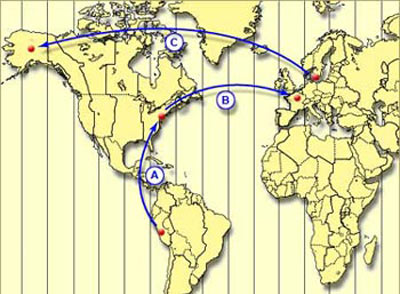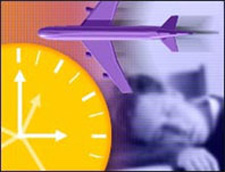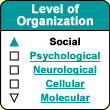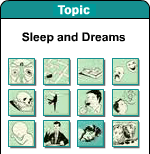|
|

The maximum jet lag
that you can experience is 12 hours. If the difference between
your flight’s departure point and its destination exceeds
12 time zones, then you have to subtract the actual number
of time zones from 24 to calculate the actual number of hours
of jet lag that you will feel. For example, if you are flying
from Los Angeles to Hong Kong, you will pass through 16 time
zones, so you will experience 24 - 16 = 8 hours of jet lag—the
same as if you had flown through 8 time zones from, say,
London, England to Los Angeles.
For flights that cross the International Date Line, the calculation
is the same, but you do not have to take the date change into
account. |
|
|
Industrial
civilization, with innovations such as night
shiftwork, variable shiftwork, and intercontinental
air travel, has subjected the human brain to conditions that evolution never
foresaw.
For instance, when a businesswoman arrives in New York on a flight from Paris,
her endogenous
circadian rhythms are still synchronized with the time
of day in the French capital, but the ambient light signals
that her brain is receiving match the time of day in the
Big Apple, which is 6 hours earlier. Thus her need for
sleep is out of phase with the local time at her destination.
The uncomfortable symptoms known as jet lag generally start to appear when the
departure and arrival points for a flight are three or more time zones apart.
The most obvious of these symptoms is sleepiness in
the daytime and wakefulness in the middle of the night. But other symptoms may
include fatigue, loss of appetite, indigestion, headaches, nausea, irritability,
and a bad mood.
Over 75% of air travellers whose flights cross several time zones
report problems in sleeping the first night afterward. But after
three nights, this figure is down to 30%. It takes just about one
day to recover for every time zone that you travel through, but
this figure varies widely from one person to the next. People who
have a very regular routine when they are at home are more sensitive
to jet lag than people who lead less structured lives.
People do not experience jet lag when they fly from north to south or south to
north, even on long-haul flights such as from Lima, Peru to New York (flight
A in the diagram below). Because these people are staying
in the same time zone, their biological clocks are not thrown off, and all
they have to deal with is the fatigue due to the long period of immobility, which
is rapidly overcome.

On this map, flight B, from New
York to Paris, passes through 6 time zones and will cause its
passengers
moderate jet lag that takes them two to three days
to overcome. Flight C, from Copenhagen to Alaska,
passes through
11 time zones, and even though it is westbound rather than eastbound
(see below), will cause
very heavy jet lag that will take a good
week to dissipate.

Westbound long-haul flights are often said to cause less jet lag
than eastbound ones passing through the same number of time zones.
Many explanations have been offered to support this assertion.
One, which applies only to eastbound flights departing in the evening,
is that passengers on such flights may get only a few hours of
darkness in which to sleep before seeing the next sunrise.
Another explanation is that because
the human biological clock’s
endogenous cycle is naturally
slightly more than 24 hours long, and because westbound flights
through more than one time zone lengthen the passengers’ days,
such flights are easier for the body to recover from than eastbound
ones. But this hypothesis would seem to contradicted by experiments
in which westbound and eastbound time lags were simulated for animals
whose endogenous cycle was almost exactly 24 hours, and these animals
too experienced fewer physiological disturbances in the westbound
case.
In short, when it comes to jet lag, so many variables seem to
be involved and there seems to be so much variability among individuals
that it is impossible to state categorically which direction of
travel is more difficult.
The usual advice for reducing the effects of jet lag is as follows.


|
- Start to adjust your body to your
destination time zone in advance. If you will be flying
east, go to bed earlier and get up earlier. If you will
be flying west, go to bed later and get up later. The extra
time you spend awake in the morning in one case and in
the evening in the other will be more effective if you
spend it in a brightly lit environment.
- As soon as your flight takes off,
set your watch to the time at your destination.
- Once you arrive at your destination,
expose yourself to sunlight to help your biological clock
reset itself more quickly.
- During the days following your arrival,
be physically active and eat a balanced diet.
- And perhaps most important, make sure
you are well rested before your flight.
|
This advice is based on today’s scientific understanding
that jet lag consists of a desynchronization between our central
biological clock and our multiple
peripheral biological clocks.
There is much controversy
about whether melatonin can
be an effective treatment for the symptoms of jet lag. In
some studies, people have reported positive effects when
they took a dose of 0.5 mg to 5 mg of melatonin at bedtime,
local time, for the first few days after they arrived at
their destination. But other studies have found that melatonin
had none of the desired effects, nor any undesirable side
effects, at least in the short term.
In some countries, such as the United States, melatonin is
freely sold as a food supplement and represents a gigantic
market, worth $US 200 to 300 million per year. These supplements
may help to regulate sleep and are therefore widely used by insomniacs.
|
|
|






